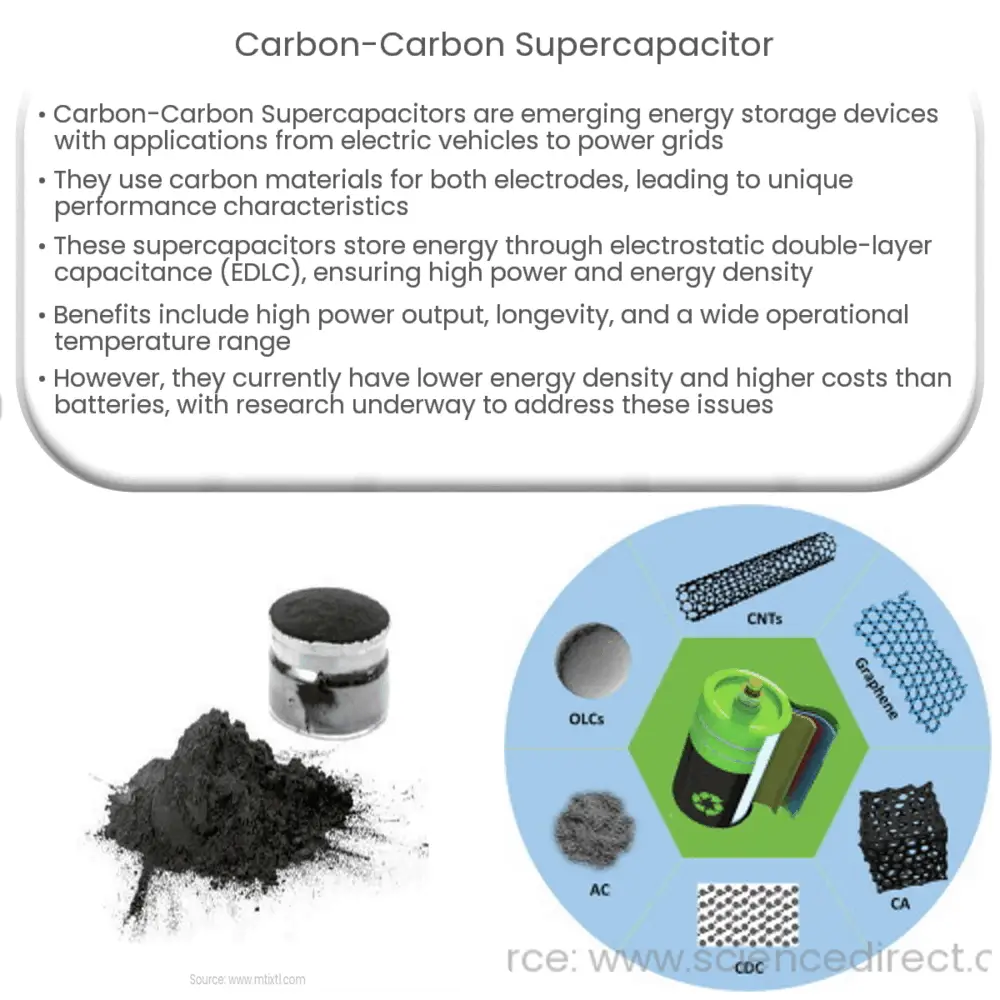Explore the world of Carbon-Carbon Supercapacitors: their working, benefits, applications, challenges, and future prospects.

Introduction to Carbon-Carbon Supercapacitors
Supercapacitors, also known as ultracapacitors or electrochemical capacitors, have emerged as a promising energy storage solution, with applications ranging from electric vehicles to power grids. One particular type, the Carbon-Carbon Supercapacitor, has received significant attention due to its unique properties and advantages.
Understanding Carbon-Carbon Supercapacitors
A Carbon-Carbon Supercapacitor is a type of supercapacitor that uses carbon material for both the positive and negative electrodes. The carbon materials used can be various forms such as activated carbon, carbon nanotubes, graphene, and others. The choice of carbon material significantly impacts the performance characteristics of the supercapacitor.
Working Mechanism of Carbon-Carbon Supercapacitors
Unlike traditional capacitors that store energy in an electric field formed by the separation of charge, supercapacitors store energy through the physical adsorption of ions from an electrolyte onto the surface of the carbon electrodes. This process, known as electrostatic double-layer capacitance (EDLC), results in high power and energy density.
- Electrode Material: The carbon-based electrodes in these supercapacitors contribute to a large surface area, which is a key factor in increasing their energy storage capacity.
- Electrolyte: The electrolyte, which can be aqueous or organic, provides the ions for charge accumulation.
- Separator: The separator prevents direct contact between the two electrodes while allowing for the free movement of ions.
When voltage is applied, ions from the electrolyte accumulate on the surface of the electrodes, creating an electric double layer. This process is highly reversible, allowing for rapid charging and discharging cycles.
Benefits of Carbon-Carbon Supercapacitors
The unique structure and working mechanism of Carbon-Carbon Supercapacitors offer several advantages over conventional energy storage systems:
- High Power Density: Due to the physical nature of energy storage (EDLC), supercapacitors can deliver energy much faster than batteries, making them ideal for applications requiring high power outputs.
- Long Lifespan: The charging and discharging process in supercapacitors involves no chemical reactions, reducing wear and tear and resulting in a longer lifespan.
- Wide Temperature Range: Supercapacitors can operate effectively over a wider temperature range compared to batteries, increasing their utility in various environments.
Applications of Carbon-Carbon Supercapacitors
Due to their unique properties, Carbon-Carbon Supercapacitors find wide-ranging applications:
- Energy Storage: Supercapacitors can be used for grid energy storage, particularly for renewable energy sources like solar and wind, where energy production is intermittent.
- Transportation: In electric vehicles, supercapacitors can provide the necessary burst of power for acceleration and also store energy from regenerative braking.
- Electronics: Supercapacitors can extend the battery life of portable electronic devices and can be used for power backup and storage in situations where a quick charge and discharge are necessary.
Challenges and Future Directions
Despite the numerous advantages and promising applications, Carbon-Carbon Supercapacitors face some challenges. The energy density of supercapacitors, while higher than traditional capacitors, is still lower than that of batteries. This means that, for the same size or weight, a battery can store more energy than a supercapacitor.
Furthermore, the cost of supercapacitors is currently higher than that of batteries, which can limit their widespread adoption. However, ongoing research is focused on addressing these limitations, with advancements in nanotechnology and new materials offering potential solutions.
Conclusion
In conclusion, Carbon-Carbon Supercapacitors represent an exciting and promising development in the field of energy storage. With their high power density, long lifespan, and versatility, they stand poised to make a significant impact across various sectors, from renewable energy to electric vehicles and portable electronics.
Despite the existing challenges, the future of Carbon-Carbon Supercapacitors appears bright, powered by relentless innovation and research. As we continue to explore and refine this technology, we can expect supercapacitors to play an increasingly important role in our energy-dependent world, helping us transition towards a more sustainable and efficient future.

